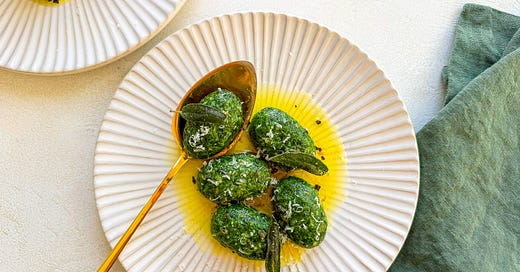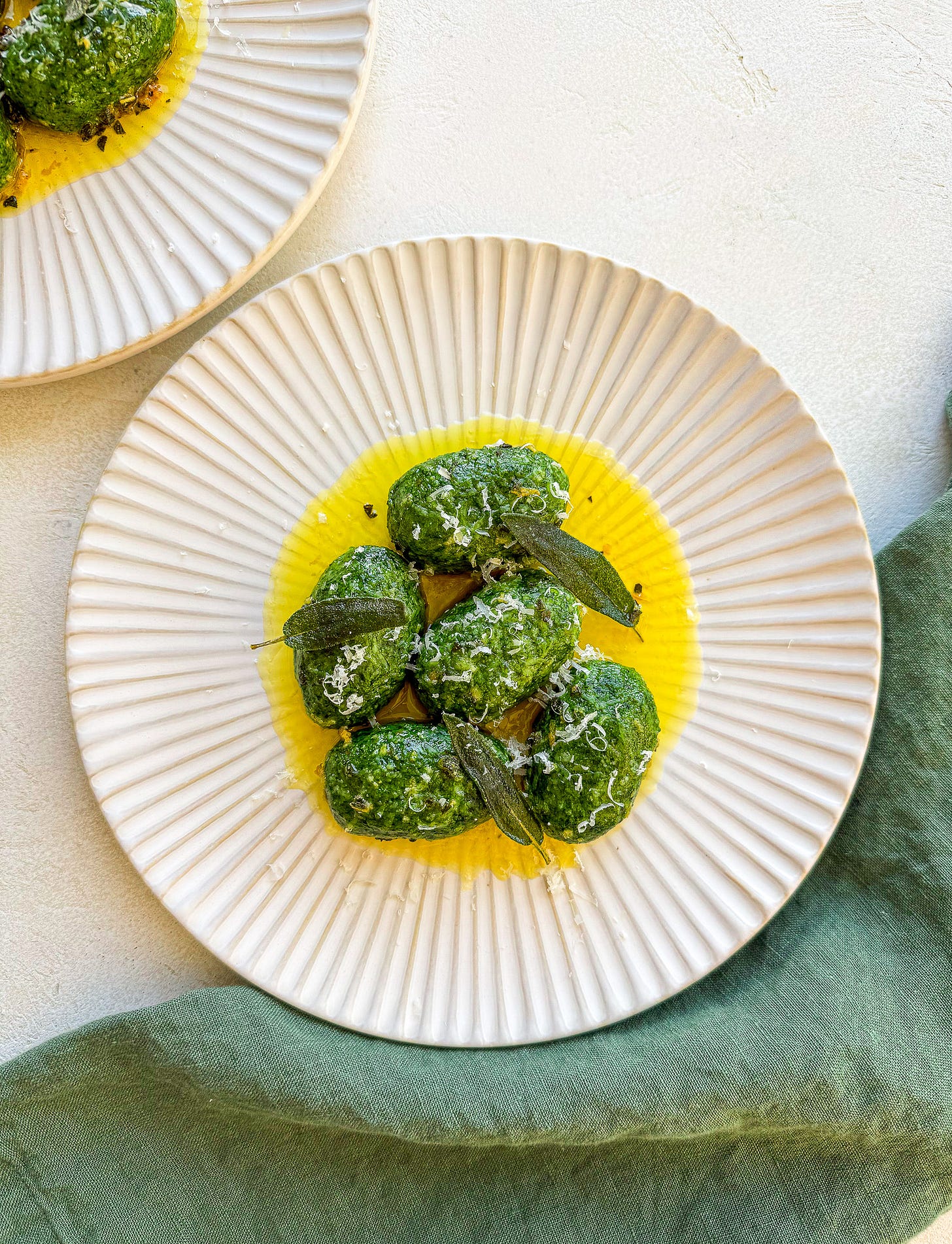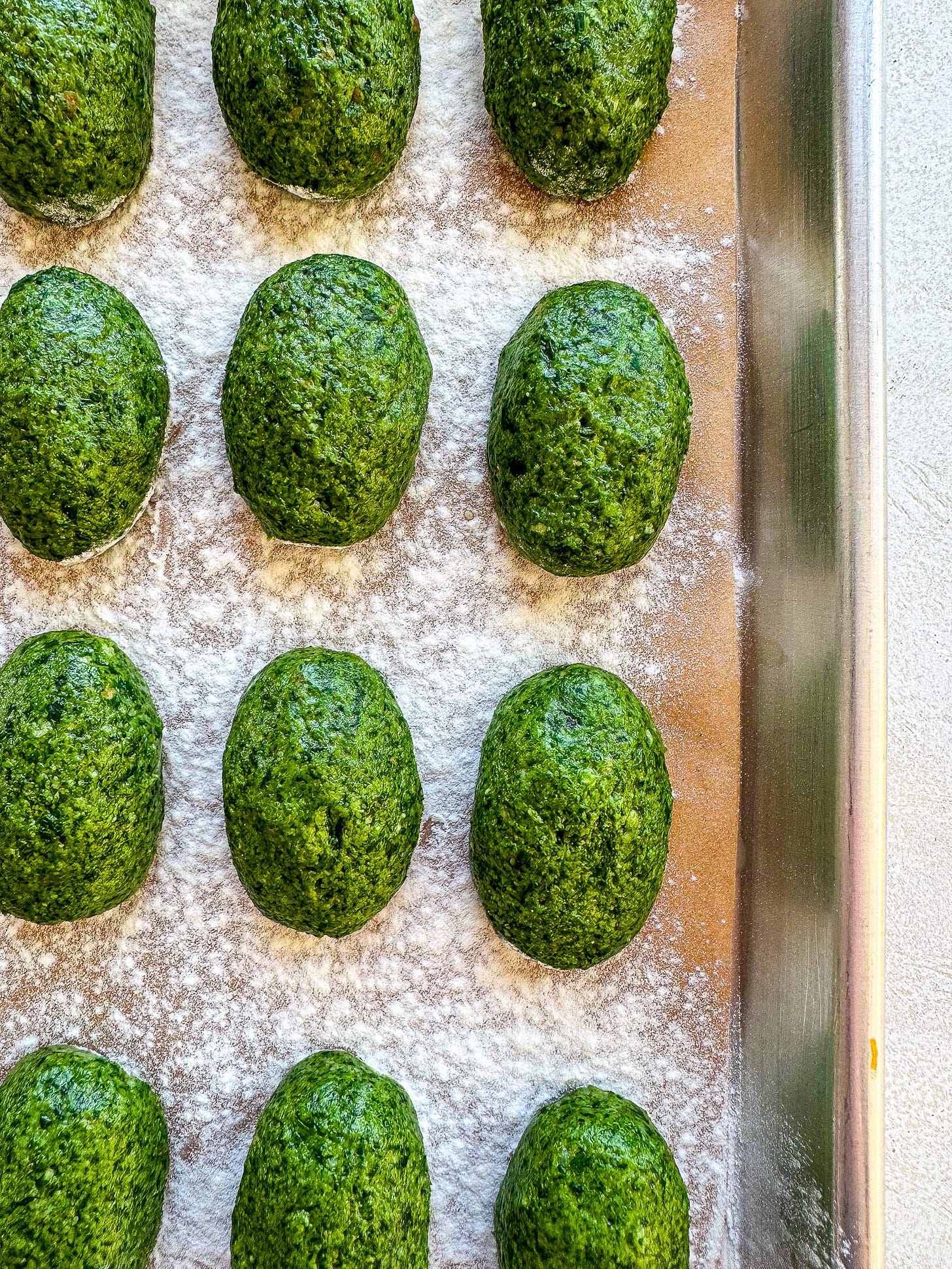strangolapreti, trentino's delicious & dangerous spinach dumplings
pasta of the month 019
Once there was a priest who loved to hunt. On one occasion, so consumed was he by the lure of the forest—or, perhaps, he was just a bit stupid—the priest set off without proper provisions and too little food to fuel his day. Upon returning home, he was ravenous, so hungry he would have eaten anything at all, even “poor and dry” polenta. So when his servant placed before him a bowl of gnocchi and greens, he ate it so quickly and “with such voracity” that the dumplings got stuck in his throat and he started to choke. The priest was lucky, because his servant was kind, and instead of leaving him to die, she struck his back again and again until he spat out “the great mouthful” and lived to see another day. Or so one story goes for how our April Pasta of the Month got its name: strangolapreti, Trentino Alto-Adige’s dangerous and delicious “priest stranglers.”*
Strangolapreti, equally called strozzapreti, are pervasive throughout Italy, one of those pastas that goes by many names and takes many forms. Like in Trentino Alto-Adige, the strangolapreti of Calabria, Friuli, and Puglia are also in the gnocchi family—some made with potatoes, others with ricotta—but head to Emilia-Romagna and strozzapreti are instead short noodles, twisted by hand and made from flour and water. In Umbria, Lazio, and Abruzzo, they might be long and spaghetti-like; in Istria, they’re a style of ravioli; in the Marche, they’re similar to maltagliati; in Naples, they’re akin to cavatelli. All totally different shapes made with totally different ingredients. I have yet to come across a more fickle pasta, but the message it sends is hardly fickle at all: Someone, at some time, in every part of Italy, really didn’t like priests.
Although our story’s protagonist was rescued despite his gluttony, the attitude toward the clergy was, for a long time, less than favorable. From as far back as the Middle Ages all the way until the 20th century, Italy’s population was primarily comprised of farmers living under mezzadria, a feudal land tenure system comprised of landowners/proprietors (padrone) and sharecroppers (mezzadri). Proprietors would provide land, housing, seeds, and tools; in exchange, sharecroppers would work the land and split the bounty. At its inception, most of Italy’s land was owned by the Catholic Church, and as such many padrone were priests. And mezzadria, which comes from mezza, or “half,” required farmers to give up half of their crops to those priests—an amount that put a strain on the large sharecropping families (usually grandparents, parents, and children living under one roof) while inflating the priests’ pockets. Worse still, not only did the priests often take more than their share, but when they came to the farmers’ homes to collect, they demanded a meal as well. So while our story’s heroine is perhaps even more valiant for rescuing her enemy, it’s more likely the name was circulated by the angry mezzadri wives who were forced to feed their greedy clergy overlords.
I’ve long loved the lore around strozzapreti, and so this is not my first recipe for this type of pasta. In the past, I’ve made the version prevalent in Emilia-Romagna—long ribbons twisted and torn by hand. But today we’re making the variety most similar to the one in our opening tale, spinach dumplings that, according to Cesare Marchi in his 1990 book Quando siamo a tavola, “look like those mossy stones that stick up around the edges of a pond; greenish, velvety, irregular.” These are the strangolapreti you’ll find in Trentino Alto-Adige and eastern Lombardy. Both regions’ recipes feature spinach or erbette (“perpetual spinach,” actually a type of Swiss chard), stale bread soaked in milk, flour, eggs, and a bit of nutmeg. In Trentino, the dumplings also include onion and cheese—so, naturally, I gravitated toward that one. I found these gnocchi unexpectedly easy to prepare and even more unexpectedly delicious—far greater that than sum of their parts. Not too light nor too heavy, they have body and bite while still being tender and luscious. They’re so tasty on their own that their typical condiment of butter and sage is all you need—though, of course, I took it one step further with the most fragrant and mouthwatering sage-garlic compound butter. You’ll also find these strangolapreti served in chicken broth, perfect for Trentino’s cold climate.
Although we’re in winter no longer, if ever there were a dish that encapsulated the tightrope between seasons, it would be this one. Verdant and wholesome, hearty and comforting, a simple and delicious way to eat more greens. And while times have changed since this pasta got its name, I know strangolapreti will be a fixture of my repertoire for many years to come.
*As told by Gian Battista Alvino in the 18th century and recounted in Oretta Zanini de Vita’s Encyclopedia of Pasta.
Strangolapreti with Sage-Garlic Butter
Serves 4 to 6; makes about 25 dumplings






